Maarten Van Segbroeck
Towards Best Practices for Open Datasets for LLM Training
Jan 14, 2025Abstract:Many AI companies are training their large language models (LLMs) on data without the permission of the copyright owners. The permissibility of doing so varies by jurisdiction: in countries like the EU and Japan, this is allowed under certain restrictions, while in the United States, the legal landscape is more ambiguous. Regardless of the legal status, concerns from creative producers have led to several high-profile copyright lawsuits, and the threat of litigation is commonly cited as a reason for the recent trend towards minimizing the information shared about training datasets by both corporate and public interest actors. This trend in limiting data information causes harm by hindering transparency, accountability, and innovation in the broader ecosystem by denying researchers, auditors, and impacted individuals access to the information needed to understand AI models. While this could be mitigated by training language models on open access and public domain data, at the time of writing, there are no such models (trained at a meaningful scale) due to the substantial technical and sociological challenges in assembling the necessary corpus. These challenges include incomplete and unreliable metadata, the cost and complexity of digitizing physical records, and the diverse set of legal and technical skills required to ensure relevance and responsibility in a quickly changing landscape. Building towards a future where AI systems can be trained on openly licensed data that is responsibly curated and governed requires collaboration across legal, technical, and policy domains, along with investments in metadata standards, digitization, and fostering a culture of openness.
Personalized Predictive ASR for Latency Reduction in Voice Assistants
May 23, 2023Abstract:Streaming Automatic Speech Recognition (ASR) in voice assistants can utilize prefetching to partially hide the latency of response generation. Prefetching involves passing a preliminary ASR hypothesis to downstream systems in order to prefetch and cache a response. If the final ASR hypothesis after endpoint detection matches the preliminary one, the cached response can be delivered to the user, thus saving latency. In this paper, we extend this idea by introducing predictive automatic speech recognition, where we predict the full utterance from a partially observed utterance, and prefetch the response based on the predicted utterance. We introduce two personalization approaches and investigate the tradeoff between potential latency gains from successful predictions and the cost increase from failed predictions. We evaluate our methods on an internal voice assistant dataset as well as the public SLURP dataset.
Efficient minimum word error rate training of RNN-Transducer for end-to-end speech recognition
Jul 27, 2020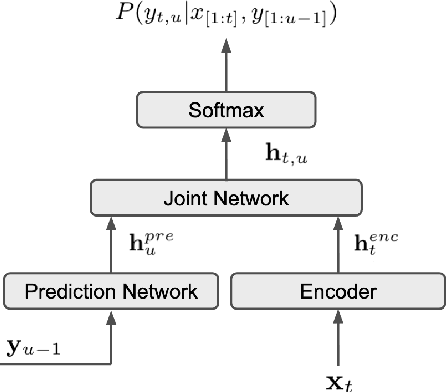


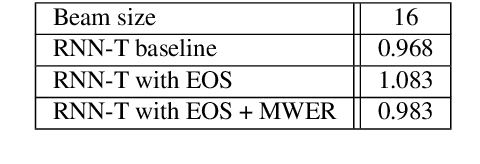
Abstract:In this work, we propose a novel and efficient minimum word error rate (MWER) training method for RNN-Transducer (RNN-T). Unlike previous work on this topic, which performs on-the-fly limited-size beam-search decoding and generates alignment scores for expected edit-distance computation, in our proposed method, we re-calculate and sum scores of all the possible alignments for each hypothesis in N-best lists. The hypothesis probability scores and back-propagated gradients are calculated efficiently using the forward-backward algorithm. Moreover, the proposed method allows us to decouple the decoding and training processes, and thus we can perform offline parallel-decoding and MWER training for each subset iteratively. Experimental results show that this proposed semi-on-the-fly method can speed up the on-the-fly method by 6 times and result in a similar WER improvement (3.6%) over a baseline RNN-T model. The proposed MWER training can also effectively reduce high-deletion errors (9.2% WER-reduction) introduced by RNN-T models when EOS is added for endpointer. Further improvement can be achieved if we use a proposed RNN-T rescoring method to re-rank hypotheses and use external RNN-LM to perform additional rescoring. The best system achieves a 5% relative improvement on an English test-set of real far-field recordings and a 11.6% WER reduction on music-domain utterances.
Multi-view Frequency LSTM: An Efficient Frontend for Automatic Speech Recognition
Jun 30, 2020Abstract:Acoustic models in real-time speech recognition systems typically stack multiple unidirectional LSTM layers to process the acoustic frames over time. Performance improvements over vanilla LSTM architectures have been reported by prepending a stack of frequency-LSTM (FLSTM) layers to the time LSTM. These FLSTM layers can learn a more robust input feature to the time LSTM layers by modeling time-frequency correlations in the acoustic input signals. A drawback of FLSTM based architectures however is that they operate at a predefined, and tuned, window size and stride, referred to as 'view' in this paper. We present a simple and efficient modification by combining the outputs of multiple FLSTM stacks with different views, into a dimensionality reduced feature representation. The proposed multi-view FLSTM architecture allows to model a wider range of time-frequency correlations compared to an FLSTM model with single view. When trained on 50K hours of English far-field speech data with CTC loss followed by sMBR sequence training, we show that the multi-view FLSTM acoustic model provides relative Word Error Rate (WER) improvements of 3-7% for different speaker and acoustic environment scenarios over an optimized single FLSTM model, while retaining a similar computational footprint.
DiPCo -- Dinner Party Corpus
Sep 30, 2019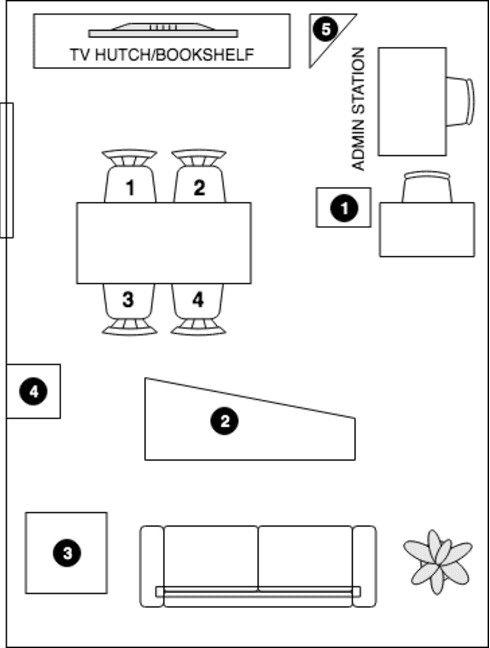
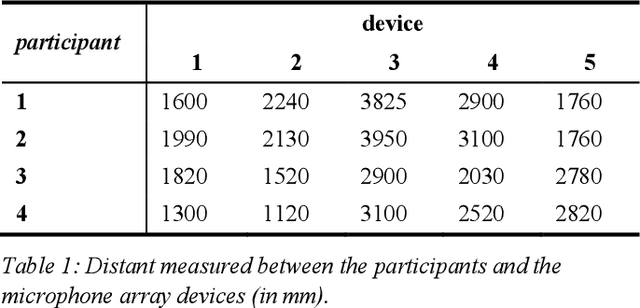
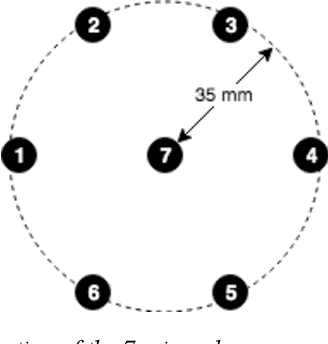

Abstract:We present a speech data corpus that simulates a "dinner party" scenario taking place in an everyday home environment. The corpus was created by recording multiple groups of four Amazon employee volunteers having a natural conversation in English around a dining table. The participants were recorded by a single-channel close-talk microphone and by five far-field 7-microphone array devices positioned at different locations in the recording room. The dataset contains the audio recordings and human labeled transcripts of a total of 10 sessions with a duration between 15 and 45 minutes. The corpus was created to advance in the field of noise robust and distant speech processing and is intended to serve as a public research and benchmarking data set.
 Add to Chrome
Add to Chrome Add to Firefox
Add to Firefox Add to Edge
Add to Edge